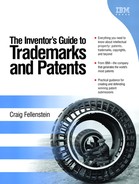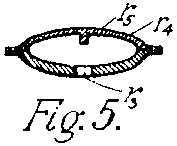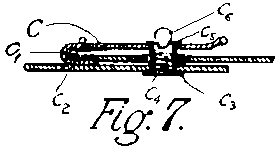An Example of an Early Patent
Let's take a look at an example of a patent granted in 1915, a life-saving device invented by Michael Kispeter,[1] to see how patents were conceived and documented during that time.
LIFE-SAVING APPARATUS; MICHAEL KISPÉTER
Patented June 22, 1915
To all whom it may concern:
Be it known that I, Michael Kispéter, a subject of the King of Hungary, residing at New York, in the county of New York and State of New York, have invented new and useful improvements in Life-Saving Apparatus, of which the following is a specification.
This invention relates to life saving apparatus and its object is to provide means whereby the life of a person dropping from an aeroplane or airship either over land or over water may be saved.
I attain my object by means of an outfit consisting of a life jacket, lined with airtight inflatable cushions, a spring helmet removably attached to the jacket and a parachute fastened to the body over the jacket, adapted to be opened and shut at the will of the wearer thereof.
In the accompanying drawings: Figure 1 is a partly sectional, partly elevational view of my device in operation, showing a person fitted out therewith. Fig. 2 is a side elevation of a part of the device. Fig. 3 is a plan of part of my device, partly broken away. Fig. 4 is a section taken on the line a-a of Fig. 3. Fig. 5 is a section taken on the line c-c of Fig. 4, on an increased scale. Fig. 6 is a detail sectional view. Fig. 7 is a sectional view of another detail.
The same reference characters refer to the same part throughout the several views. Fascinating . . . you may do this already, but it would be interesting to understand how the expectations of patent documentation have changed over the years.
Drawing J is a jacket substantially of the shape of an ordinary coat, having two side tails j1, the front and rear part being cut away below the waist. This jacket is lined at the inside with air-cushions j2 made of rubber, two at the front and two at the back of the body portion and one on each side tail, j3. The jacket J is buttoned at the front from neck to waist and if the wearer thereof falls into water, the two coats will, on account of the buoyancy of the air cushions, float on the surface of the water, coacting with the air cushions in the body part of the jacket to keep the wearer afloat.
Over the jacket J is strapped a parachute P consisting of two parallel cylindrical hoops p1, each of two parts hinged together at the back and having means for closing or opening it at the front. The two hoops p1 are connected with each other by six vertical bars p2 placed equidistantly around their periphery. Hinged to the top end of each bar p2 are ribs R and hinged to the lower end of each bar p2 are stays S. On top of the ribs R is conveniently fastened at a substantially circular cover F of some suitable fabric, with a circular opening at its center around the hoops p1. The cover F is slit at the front, the edges overlapping each other and held together by clasps C.
The ribs R are halfround metal bars, having a concave portion from r1 to r2 slotted as at r3 and covered by a convex lid r4 removably secured thereto and forming an elliptical channel therewith. The lid r4 has all along its inside a vertical projection or guide rail r5.
The stays S are flat bars of light metal, forked at their outer ends and carrying between the prongs s1 of the fork pivotally mounted swiveling blocks s2, provided with a screw hole each at its outer surface adapted to take up therein the threaded stem of a screw s3, having a head s4 with a groove s5 diagonally to the length of the stays S. The screw s3 is inserted into the slot r2 in the concave portion of the ribs R, when the lid r4 is removed there from and screwed into the swiveling block s2 so that the groove s5 is parallel with the length of the rib R. Then the lid r4 is fastened on, the guardrail r5 engaging the groove s5, which is adapted freely to slide thereon. Straps p3 are provided on top of the two of the ribs diametrically opposite, for slipping the hand into and thereby open or shut the parachute.
The clasping device of the cover of the parachute consists of a metal clasp C of the form shown in Fig. 7 suitably fastened on the fabric at a convenient distance from one edge of same, having a hinge c1 and a spring c2 tending to keep it open. A small metal cup c3 is passed through the fabric near the same edge thereof to which the clasp is fastened. Attached to the bottom of the cup c3 is one end of the helical spring c4 and to the other end of it is fastened a resilient plate c5, integral with a pushbutton c6. The two ends of the resilient metal plate c5 overlie the upper edges of the cup and the edges of the circular aperture in the clasp C, fitting over the cup, thus preventing it to open. The other edge of the fabric is provided with eyelets fitting over the cup c3 and the two edges are clasped together as shown in Fig. 7. If the button c4 is pressed down by a finger, the metal plate c5 will be forced into the cup c3, thereby releasing the clasp C which will then automatically be opened by the action of the spring c2. When clasped together again, the spiral spring c4 will push the metal plate c5 and button c6 out again of the cup c3.
H is a cylindrical metal helmet having a solid rubber lining h1 inside the top and a metal plate h2 under the rubber. To the metal plate h2 is fastened a helical spring h3, resting on another metal plate underneath it, h4, which projects through horizontal slots in the cylindrical body of the metal helmet on both sides and is continued in two bars running down vertically to the shoulders of the wearer and there shaped like epaulets as shown at h5, removably attached to the shoulder portions of the jacket J. At the back the material of the helmet is prolonged to the back of the jacket J, where it is removably fastened to, as seen at h6. The helmet is supported on the shoulders of the wearer by means of the bars h5 just above the head of the person and not resting thereon.
It will be readily understood from this description of my invention that a person falling from the air, equipped with my life saving apparatus, will first open the parachute by means of raising slightly the hands slipped in the straps over the ribs, the rest being done by pressure of the air against the lower surface of the fabric covering the parachute. Should the person fall into water, the air cushions will keep him or her afloat and should the respective person fall on land and the parachute not assure a descent smooth enough to prevent a violent impact with same, the impact will considerably be reduced also by the air cushions. Should the person fall head foremost the sides of the helmet will break on contact with the soil and the resilient means contained in the helmet will mitigate the concussion.
While I have thus shown and described the preferred form of my invention, it is understood that I do not wish to be limited to its mechanical details and may resort to alterations and modifications, which come within the scope of the claims hereunto appended.
What I claim as new and wish to secure by Letters Patent is:
A life saving apparatus, for aeronauts, comprising, in combination, a jacket lined with air-tight inflatable cushions, a parachute adapted to be easily opened and closed, removably attached to the body over said jacket, and a helmet supported over the head of the wearer by means of supports attached removably to the shoulder and back portions of said jacket, resilient means in said helmet, substantially as and for the purpose set forth.
A life saving helmet, comprising, in combination, a cylindrical body portion closed at the top, said top lined at the inside with resilient material, a helical spring between two metal plates within said cylindrical body, projections of the lower of one of said plates piercing the sides of said cylindrical body, adapted to be fastened to the shoulder portions of a life saving jacket, and to support said helmet just above the head of the wearer, and a prolongation of the material covering said helmet adapted to be removably fastened to the back portion of a life saving jacket, substantially as and for the purpose set forth.
In testimony whereof, I have hereunto fixed my signature in the presence of two witnesses.
MICHAEL KISPÉTER.
Witnesses:
ABADAR HAMBURGER.
Between the years of 1561 and 1590, Queen Elisabeth I granted about 50 patents on the manufacture and sale of common things (like those mentioned above). During Queen Elisabeth and her successor, King James I's, respective reigns, there were mounting concerns and overall discontent about the state of the patent system. It came to a head in the year 1624 and was resolved by the publication of the Book of Bounty, which stated that “monopolies are things contrary to our laws” and “projects of new invention so they were not contrary to the law, nor mischievous to the state by raising prices at home or hurt of trade.” The Statute of Monopolies was also published in conjunction with Book of Bounty. It limited to 14 years the time of power that the state had in giving out monopolies and “manners of new manufacture” (in other words, new inventions).
This reform satisfied the people, and there was no alteration to the English patent law for nearly 200 years. During the reign of Queen Anne, a condition was added to the law stating, “The patentee must, by an instrument in writing, describe and ascertain the nature of the invention and the manner in which it is performed.” James Puckle created the first invention with the new required specifications in 1718. It was for a machine gun.
Article I, section 8 of the United States Constitution says: “The Congress shall have power . . . to promote the progress of science and useful arts by securing for limited times to authors and inventors the exclusive right to their respective writing and discoveries.” In 1790, two years after the ratification of the U.S. Constitution, the newly formed United States as a nation passed its first patent statute.







